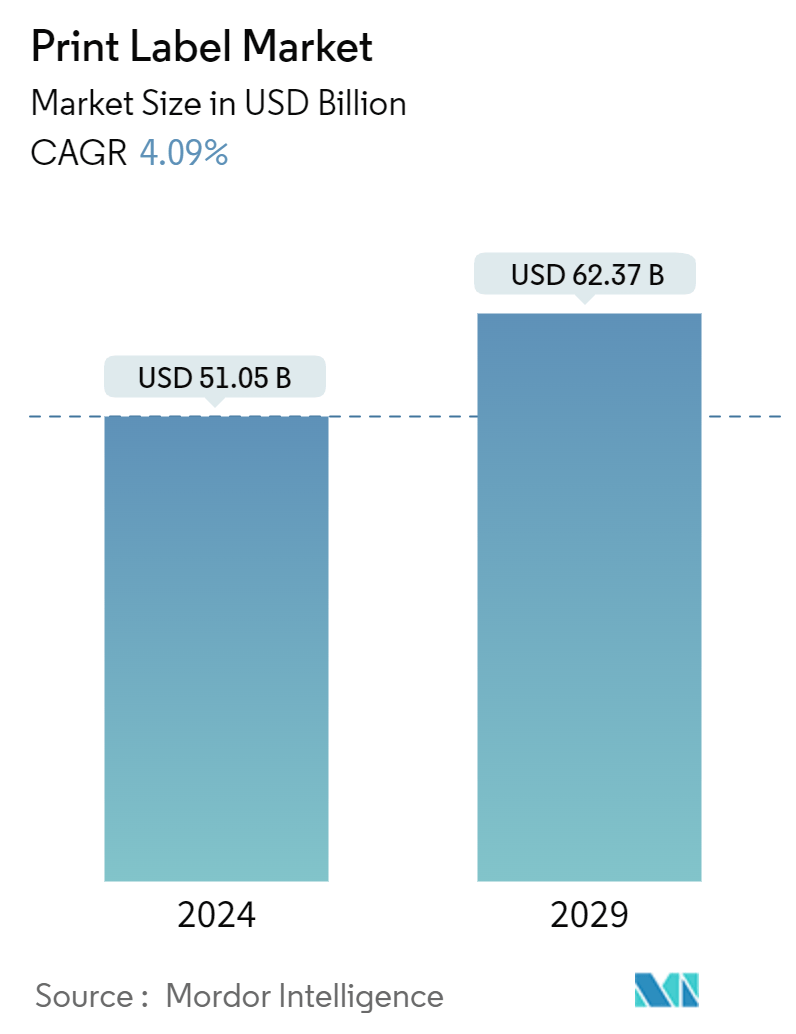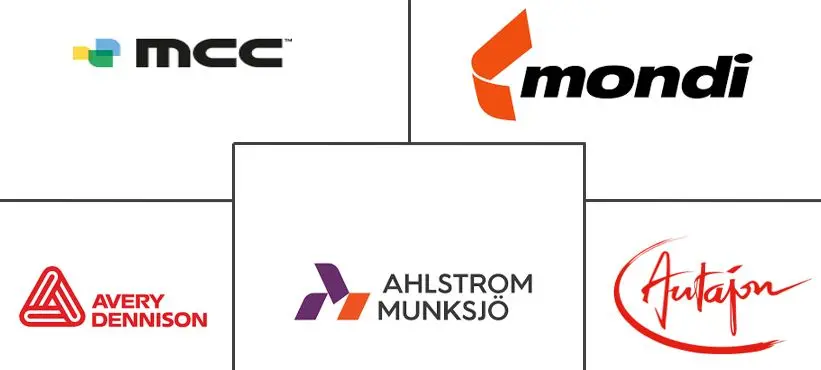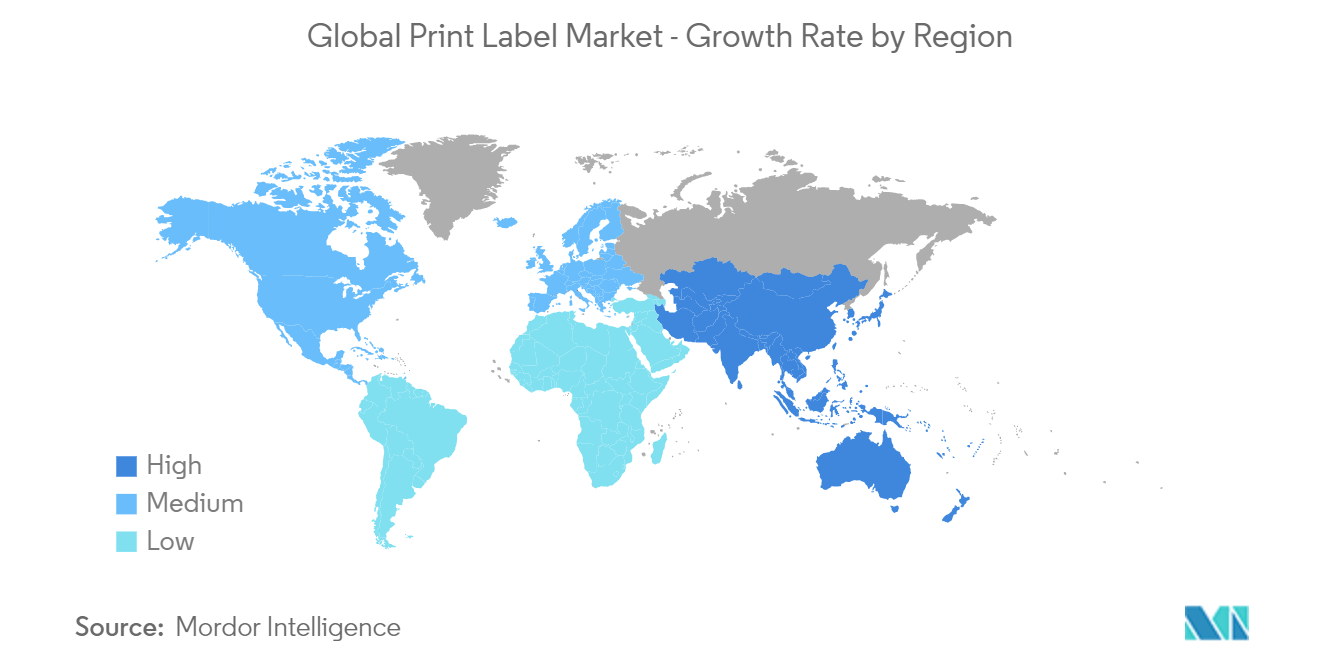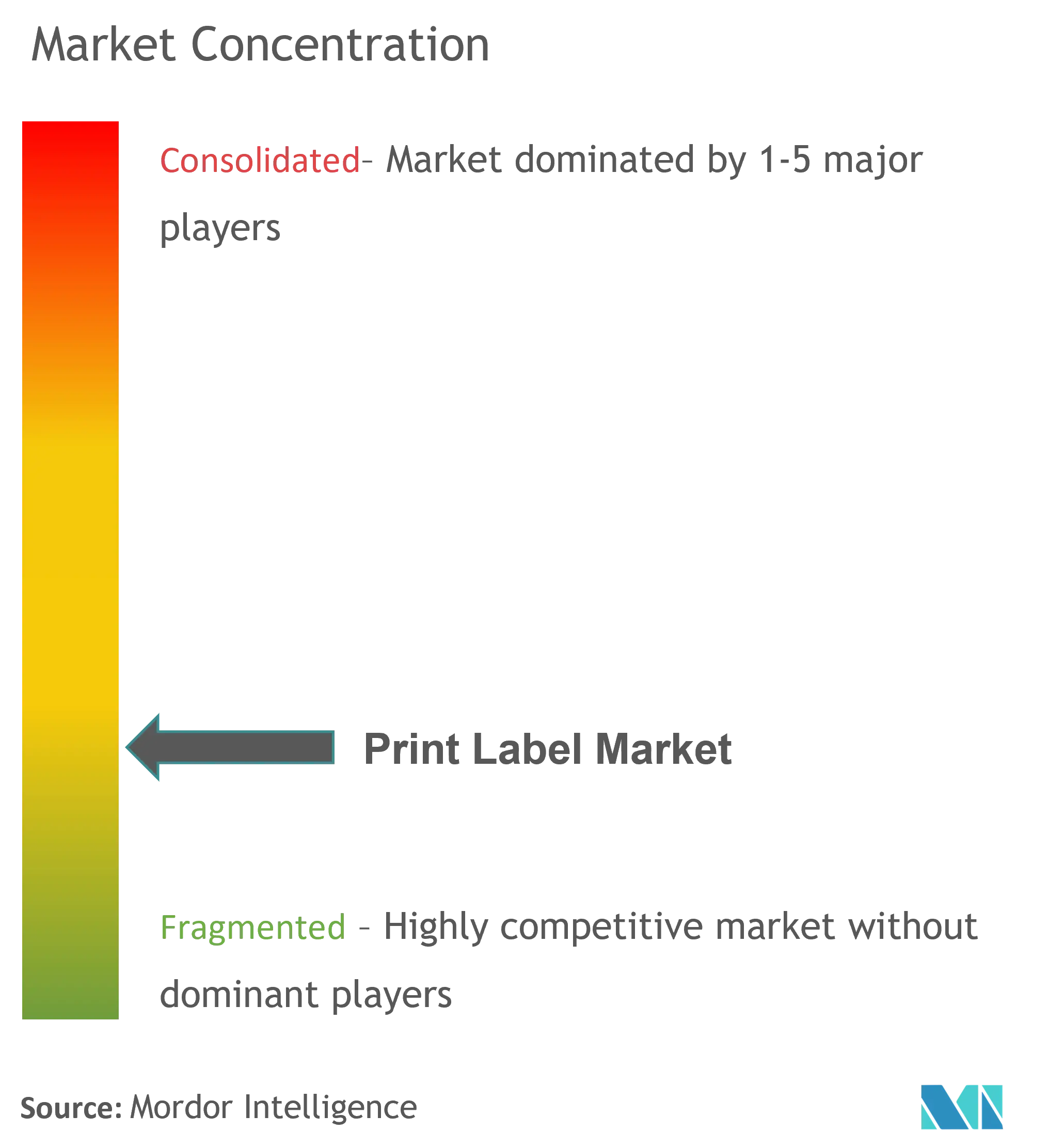Print Label Market Size

| Study Period | 2022 - 2029 |
| Market Size (2024) | USD 51.05 Billion |
| Market Size (2029) | USD 62.37 Billion |
| CAGR (2024 - 2029) | 4.09 % |
| Fastest Growing Market | Asia Pacific |
| Largest Market | North America |
Major Players
*Disclaimer: Major Players sorted in no particular order |
Print Label Market Analysis
The Print Label Market size is estimated at USD 51.05 billion in 2024, and is expected to reach USD 62.37 billion by 2029, growing at a CAGR of 4.09% during the forecast period (2024-2029).
The print label market is witnessing a surge in demand for more appealing brands. This is fueled by several factors, such as a rise in SKUs, shorter product life cycles, and heightened regulatory requirements on labels. Additionally, as the demand for manufactured goods grows and disposable incomes rise, the print label market is poised for further expansion.
Several key players, including Nilpeter, Xeikon, and Bobst Firenze, assert that digital labels not only meet market demands but also outperform traditional printing methods.
Digital technology has proven adept at meeting diverse industry needs, crafting appealing label designs that entice consumers. While integrating digital tech with existing printing methods promises to revolutionize sectors of all sizes, stringent environmental labeling regulations pose a challenge.
Label application challenges, largely stemming from environmental factors like temperature and humidity, demand careful handling. Labels fare best when applied in dry, room-temperature conditions, although navigating extremes, especially in winter, summer, or cold storage, can be tricky.
Market players are doubling down on sales and distribution channels. For instance, Xeikon's innovation center in Shanghai caters to China's growing needs, offering a platform for testing applications and exploring new revenue streams. Meanwhile, Domino is bolstering its digital printing arm, which is evident in its recent North American service hires.
The pandemic underscored two major hurdles for label companies, i.e., enhancing productivity and providing remote customer support. As demand surged post-pandemic, companies faced capacity strains, emphasizing the urgency of automation across product life cycles.
Print Label Market Trends
The Food Industry to Create Significant Demand During Forecast Period
- The food industry is poised to dominate the print label market in the coming years. Consumers today exhibit heightened awareness regarding the contents of their food. This has led to a pronounced focus on the materials listed on product labels, prompting manufacturers to lean toward more prominent branding.
- Furthermore, the surging demand for packaged foods, driven by their assurance of quality, safety, and extended shelf life, is a key factor propelling the print label market. Data from the Federation of Indian Chambers of Commerce & Industry (FICCI) highlights that the expenditure on packaged foods is on the rise, attributed to factors like escalating per capita incomes, urbanization, and the increasing working hours for women.
- With the advancement of global economies, there is a notable uptick in the presence of modern retail outlets, including supermarkets and convenience stores. These outlets, particularly in emerging markets, are increasingly stocking a wider array of frozen food products. The Organisation for Economic Co-operation and Development (OECD) underscores a significant rise in the popularity of frozen and packaged foods. Notably, Germany saw a remarkable 56% surge in sales of personalized packaged foods.
- Insights from Label Insight and the Food Marketing Institute revealed that a staggering 86% of shoppers prioritize transparency when grocery shopping. They express a higher level of trust in food manufacturers and retailers who offer comprehensive and easily understandable ingredient information.

Asia-Pacific is Expected to Hold a Major Share
- China, driven by heightened corporate interest, stands as the dominant economy in Asia-Pacific. All end-user industries in the country are witnessing growth, with a rapidly growing economy bolstered by a surging population, rising living standards, and increasing per capita income.
- The ascent of e-commerce powerhouses, exemplified by Alibaba, is poised to propel the print labels market in China over the coming years. As a testament to this, during Alibaba's Double 11 shopping extravaganza, Chinese consumers were inundated with nearly 1.9 billion packages.
- Not to be outdone, the e-commerce surge in India is primed to drive the adoption of print labels. Projections from Invest India suggest that the Indian e-commerce landscape is on track to achieve a 30% CAGR, aiming for a USD 200 billion gross merchandise value by 2026, with a market penetration target of 12%, a significant leap from the current 2%.
- Highlighting the trend, Australia's e-commerce scene saw a notable surge. As per the Australia Post's e-commerce industry report, consumers spent a hefty USD 310.29 billion on retail sales, marking a 9.7% increase from the previous year. Online purchases, reflecting heightened consumer engagement, soared by 57% year-on-year, with a record USD 50.46 billion spent online, constituting 16.3% of total retail sales. This is a milestone the nation is eyeing for the upcoming year.
- Further underlining the industry's vigor, in March of the previous year, Multi-Color Corporation, a leading label entity, made waves with its acquisition of Herrods. Based in Melbourne, Australia, Herrods specializes in in-mold label (IML) solutions, catering to markets in Australia and New Zealand. Herrods was already on a growth trajectory, expanding its operations to meet the escalating demand. Multi-Color Corporation's move was strategic, aiming to leverage this added capacity to enhance service offerings for both new and existing clientele in the region.

Print Label Industry Overview
The print label market is highly competitive and consists of several major players, such as Multi-Color Corporation, Mondi Group, Avery Dennison Corporation, Ahlstrom-Munksjo Oyj, and Autajon Group. The market is highly fragmented. Many companies are increasing their market presence by introducing new products or entering into strategic partnerships or acquisitions.
- January 2024: Avery Dennison debuted its innovative AD LinrSave technology at Labelexpo Europe 2023, marking the initial move in its strategy to revolutionize the pressure-sensitive prime label segment.
- September 2023: Sappi, a specialist paper manufacturer, announced the expansion of its wet-glue label paper range. The new addition, Parade Label Pro WS, boasts enhanced wet strength and alkali resistance. This product is being manufactured at Sappi's Gratkorn facility in Austria.
Print Label Market Leaders
-
Multi-Color Corporation
-
Mondi Group
-
Avery Dennison Corporation
-
Ahlstrom-Munksjo Oyj
-
Autajon Group
*Disclaimer: Major Players sorted in no particular order

Print Label Market News
- June 2024: DYMO, a prominent player in cutting-edge labeling solutions under Newell Brands, joined forces with Taylor, a distinguished custom label manufacturer. This collaboration introduced custom-printed LabelWriter labels tailored for the DYMO LabelWriter 5 Series printers.
- September 2023: Sabic, in collaboration with three leading in-mold labeling (IML) companies, unveiled a breakthrough, i.e., the adoption of certified renewable polypropylene (PP) resins in premium mono-PP thin-wall container packaging. This innovation maintains quality, processability, safety, and convenience standards.
Print Label Market Report - Table of Contents
1. INTRODUCTION
- 1.1 Study Assumptions and Market Definition
- 1.2 Scope of the Study
2. RESEARCH METHODOLOGY
3. EXECUTIVE SUMMARY
4. MARKET INSIGHTS
- 4.1 Market Overview
-
4.2 Industry Attractiveness - Porter's Five Forces Analysis
- 4.2.1 Bargaining Power of Suppliers
- 4.2.2 Bargaining Power of Buyers/Consumers
- 4.2.3 Threat of New Entrants
- 4.2.4 Threat of Substitutes
- 4.2.5 Intensity of Competitive Rivalry
- 4.3 Industry Value Chain Analysis
- 4.4 Assessment of the Impact of COVID-19 on the Market
5. MARKET DYNAMICS
-
5.1 Market Drivers
- 5.1.1 Evolution of Digital Print Technology
- 5.1.2 Increased Focus toward Manufacturing in the Developing Economies
-
5.2 Market Challenges
- 5.2.1 Lack of Products with Ability to Withstand Harsh Climatic Conditions
6. MARKET SEGMENTATION
-
6.1 By Print Process
- 6.1.1 Offset lithography
- 6.1.2 Gravure
- 6.1.3 Flexography
- 6.1.4 Screen
- 6.1.5 Letterpress
- 6.1.6 Electrophotography
- 6.1.7 Inkjet
-
6.2 By Label Format
- 6.2.1 Wet-glue labels
- 6.2.2 Pressure-sensitive labels
- 6.2.3 Linerless labels
- 6.2.4 Multi-part tracking labels
- 6.2.5 In-mold labels
- 6.2.6 Shrink and Stretch Sleeves
-
6.3 By End-user Industries
- 6.3.1 Food
- 6.3.2 Beverage
- 6.3.3 Healthcare
- 6.3.4 Cosmetics
- 6.3.5 Household
- 6.3.6 Industrial (Automotive, Industrial Chemicals, and Consumer and Non-consumer Durables)
- 6.3.7 Logistics
- 6.3.8 Other End-user Industries
-
6.4 Geography
- 6.4.1 North America
- 6.4.1.1 United States
- 6.4.1.2 Canada
- 6.4.2 Europe
- 6.4.2.1 United Kingdom
- 6.4.2.2 Germany
- 6.4.2.3 France
- 6.4.2.4 Spain
- 6.4.2.5 Italy
- 6.4.2.6 Poland
- 6.4.2.7 Netherlands
- 6.4.2.8 Rest of Europe
- 6.4.3 Asia-Pacific
- 6.4.3.1 China
- 6.4.3.2 India
- 6.4.3.3 Japan
- 6.4.3.4 Australia
- 6.4.3.5 South Korea
- 6.4.3.6 Rest of Asia-Pacific
- 6.4.4 Latin America
- 6.4.4.1 Brazil
- 6.4.4.2 Mexico
- 6.4.4.3 Rest of Latin America
- 6.4.5 Middle East and Africa
7. COMPETITIVE LANDSCAPE
-
7.1 Company Profiles
- 7.1.1 Multi-Color Corporation
- 7.1.2 Mondi Group
- 7.1.3 Avery Dennison Corporation
- 7.1.4 Ahlstrom-Munksjo Oyj
- 7.1.5 Autajon Group
- 7.1.6 Fort Dearborn Company
- 7.1.7 CCL Industries
- 7.1.8 Multi Packaging Solutions (WestRock Company)
- 7.1.9 Clondalkin Group
- 7.1.10 Cenveo Corporation
- 7.1.11 Brady Corporation
- 7.1.12 Fuji Seal International Inc.
- 7.1.13 Constantia Flexibles Group GmbH
- 7.1.14 R.R. Donnelley & Sons Company
- 7.1.15 3M Company
- 7.1.16 Taylor Corporation
- 7.1.17 Huhtamaki OYJ
- 7.1.18 Taghleef Industries Inc.
- 7.1.19 Ravenwood Packaging
- 7.1.20 Sato America
- 7.1.21 Coveris
- 7.1.22 Fedrigoni Self-Adhesives (Fedrigoni Group)
- 7.1.23 ePac Holdings LLC
- 7.1.24 Neenah Inc.
- *List Not Exhaustive
8. INVESTMENT ANALYSIS
9. FUTURE OUTLOOK OF THE MARKET
** Subject To AvailablityPrint Label Industry Segmentation
A print label, whether paper, plastic, cloth, metal, or another material, is attached to a product or container and bears essential information or symbols about the product. This information can also be directly printed on the container or item. Print labels serve as the key communication channel between a company and its customers. They play a pivotal role in shaping a consumer's perception of a product and in leaving a lasting impression on their minds.
The print label market is segmented by print process (offset lithography, gravure, flexography, screen, letterpress, electrophotography, and inkjet), label format (wet-glue labels, pressure-sensitive labels, linerless labels, multi-part tracking labels, in-mold labels, and shrink and stretch sleeves), end-user industry (food, beverage, healthcare, cosmetics, household, industrial, and logistics), and geography (North America (United States and Canada), Europe (United Kingdom, Germany, France, Spain, Italy, Poland, Netherlands, and Rest of Europe), Asia-Pacific (China, India, Japan, Australia, South Korea, and Rest of Asia-Pacific), Latin America (Brazil, Mexico, and Rest of Latin America), and Middle East and Africa). The market sizes and forecasts are provided in terms of value (USD) for the above segments.
| By Print Process | Offset lithography | |
| Gravure | ||
| Flexography | ||
| Screen | ||
| Letterpress | ||
| Electrophotography | ||
| Inkjet | ||
| By Label Format | Wet-glue labels | |
| Pressure-sensitive labels | ||
| Linerless labels | ||
| Multi-part tracking labels | ||
| In-mold labels | ||
| Shrink and Stretch Sleeves | ||
| By End-user Industries | Food | |
| Beverage | ||
| Healthcare | ||
| Cosmetics | ||
| Household | ||
| Industrial (Automotive, Industrial Chemicals, and Consumer and Non-consumer Durables) | ||
| Logistics | ||
| Other End-user Industries | ||
| Geography | North America | United States |
| Canada | ||
| Geography | Europe | United Kingdom |
| Germany | ||
| France | ||
| Spain | ||
| Italy | ||
| Poland | ||
| Netherlands | ||
| Rest of Europe | ||
| Geography | Asia-Pacific | China |
| India | ||
| Japan | ||
| Australia | ||
| South Korea | ||
| Rest of Asia-Pacific | ||
| Geography | Latin America | Brazil |
| Mexico | ||
| Rest of Latin America | ||
| Geography | Middle East and Africa |
Print Label Market Research FAQs
How big is the Print Label Market?
The Print Label Market size is expected to reach USD 51.05 billion in 2024 and grow at a CAGR of 4.09% to reach USD 62.37 billion by 2029.
What is the current Print Label Market size?
In 2024, the Print Label Market size is expected to reach USD 51.05 billion.
Who are the key players in Print Label Market?
Multi-Color Corporation, Mondi Group, Avery Dennison Corporation, Ahlstrom-Munksjo Oyj and Autajon Group are the major companies operating in the Print Label Market.
Which is the fastest growing region in Print Label Market?
Asia Pacific is estimated to grow at the highest CAGR over the forecast period (2024-2029).
Which region has the biggest share in Print Label Market?
In 2024, the North America accounts for the largest market share in Print Label Market.
What years does this Print Label Market cover, and what was the market size in 2023?
In 2023, the Print Label Market size was estimated at USD 48.96 billion. The report covers the Print Label Market historical market size for years: 2022 and 2023. The report also forecasts the Print Label Market size for years: 2024, 2025, 2026, 2027, 2028 and 2029.
Label Printing Industry Report
Statistics for the 2024 Label Printing market share, size and revenue growth rate, created by Mordor Intelligence™ Industry Reports. Label Printing analysis includes a market forecast outlook to 2029 and historical overview. Get a sample of this industry analysis as a free report PDF download.



